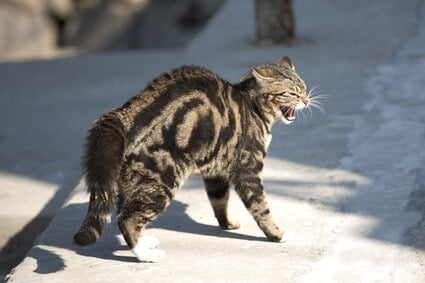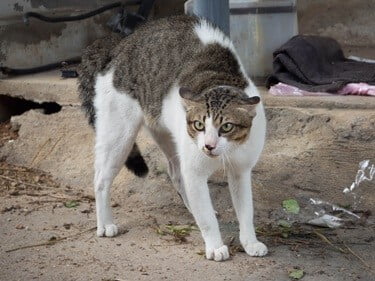Dealing with an enraged cat can be intimidating. Cats may be small, but they can have unpredictable actions. If your cat is in a state of emotional distress, it needs time and space.
Never approach an angry cat until it’s ready. Annoyance could manifest as aggression, and you may get clawed or bitten. Find out why your cat is upset and give it space. After a short period, provide a peace offering, such as food. A meal or snack will distract your cat from its annoyance. Conclude the cat’s calming with play to restore harmony.
It’s unhealthy for cats to experience heightened emotions, such as anger. Cats are happiest when living a serene lifestyle, devoid of antagonism. So, avoid any behavior that’s likely to cause feline frustration.
Do Cats Get Angry?
Cats have a reputation as aloof, emotionless animals. Such a misconception could not be further from the truth. Felines experience a range of complex emotions. This emotional spectrum includes anger and frustration.
The Journal of Feline Medicine and Surgery explains how understanding feline emotional well-being is just as important as physical health. If your cat is angry and upset, an owner must acknowledge this emotional state. Failure to do so could adversely affect the human-feline bond.
How to Tell If A Cat is Angry
Cats make it hard to determine their mood. Thankfully, there are other ways to gain insight into a cat’s emotional state. Learning the meaning of feline body language and verbalizations is critical.
Just because your cat is not responding to you does not necessarily mean that the cat is feeling angry and annoyed. In fact, as per Current Biology, this suggests that you share a secure bond with your cat. Incensed cats often make their displeasure quite clear. Watch out for any of the following, or a combination of these characteristics:
- Standing with an arched back (Halloween cat position)
- Agitated verbalizations, such as hissing or growling
- Tail is sweeping the ground
- Eyes are wide and staring
- Ears are flat against the head
- The mouth appears tensed and the cat is baring teeth
- Claws are unsheathed and ready for use
If your cat is annoyed, you should learn why. There are a plethora of explanations. The blame may lay with you or with an external source. Either way, it will be helpful to know what aggrieved your cat to avoid a future repeat.
What Makes Cats Angry?
If you have ever wondered, “why is my cat angry?” you are not alone. Cats can be agitated by a range of seemingly innocuous things. Sometimes, though, feline fury has an understandable explanation.
Sudden Waking
Cats love to sleep. Such passion for naps is not just an act of laziness. The simple act of being awake and moving around is exhausting for felines. Senior cats, in particular, find movement to be a real workout. Arthritic joints require rest to recover from exertion.
If your cat is in a deep sleep, it must not be disturbed. Such a scenario may be frustrating if the cat is in your way or sleeping on top of something you need. Rousing a cat from a deep sleep before it is ready will infuriate a cat.
Cats feel vulnerable when they sleep. For a cat to doze in a public space in a home is a sign of confidence and trust. Waking the cat is a betrayal of this trust. The cat will immediately react with anger.
Unwanted Handling
If you must handle your cat, do so sparingly. Cats like to keep all four paws on the ground and call the shots regarding handling. Picking up a cat unexpectedly, especially from behind, will cause anger.
Handling a cat is sometimes unavoidable. You may need to administer a flea treatment, for example. An action like this should not be enough to agitate or anger a cat. Placing your cat in the bath is another story. Expect to fall out with your cat in this instance, at least temporarily.
Simply petting a cat can also anger your feline companion. Cat skin is sensitive. While contented purring will be the initial reaction, the cat may grow agitated. If the skin is overstimulated, petting grows painful.
Look out for signs that your cat has had enough physical attention. Body language cues could include squirming in your lap, tensing the body, and observing your hands. The purring may stop. At the very least, the tone will change.
If you ignore these signs, the cat will grow annoyed. It will feel as though you are not listening and paying attention to its cues. Overstimulation will likely end with a scratch or bite before the cat walks away. Avoid letting things get this far.
Remember the golden rule of cat handling – avoid rubbing the soft underbelly and touching the paw pads. Cats usually detest being touched in these places, as they are so delicate.
Physical Pain
Pain and aggressive behavior go hand-in-hand for felines. Cats loathe revealing that they are in discomfort. If your cat is uncharacteristically volatile, it may be in pain. If you step on your cat’s tail, it will initially react with anger.
It’s common for a cat to be mad after a vet visit. The trip may be for a necessary evil, such as a vaccination. If your cat undergoes significant or minor surgery, it will be even more agitated afterward. The after-effects will be keenly felt.
Cats recover from a trip to the vet before too long. In addition, your cat will eventually forgive you for subjecting it to such prodding and poking. Such absolution may take a while, though. You will likely need to make amends through food, toys, or treats.
If your cat has not been to the vet, it may be time to schedule a visit. Your pet may be experiencing pain through an undiagnosed sickness. Dental pain, for example, is common. Alternatively, your cat may have a UTI or other infection.
Invasion of Territory
To cats, territory is everything. When a cat claims an area for itself, it will guard it jealously. Invading territory makes a cat instantly furious. This infiltrator could be another pet or an owner.
Any cat should have territory within a home. Ideally, this will be an entire, little-used room. If this is not an option, the corner of a communal space will be fine. Wherever this territory may be, consider it sacred.
Other cats will understand this. If you have a multi-cat household, the felines will rarely encroach on each other’s terrain. Any unwelcome visitor will quickly be chased away in no uncertain terms.
Respect for territory applies to humans too. Cleaning a cat’s environment will be seen as an act of aggression. Removing items that a cat has carefully collected will cause considerable anger. Disturbing a cat relaxing in its terrain is a strict no-no.

Frustrated Instincts
Instincts and urges govern the behavior of domesticated cats. If the cat is unable to act upon these, it will grow agitated.
Take hunting, for example. All cats love to hunt. Senior cats may slow down in their stalking of prey, as they can no longer move as quickly. Preventing a cat from hunting will lead to frustration, though.
An example is cats watching birds through a window. A cat will initially be content to observe from indoors. After a while, though, the cat will start to verbalize and claw at the window. The hunting instinct is taking over, and the cat wants to get amongst traditional prey.
You should also spay a female cat if you are concerned about aggressive behavior. A cat in heat will experience significant mood swings. Such cats are affectionate one moment and positively demonic the next.
Again, this comes down to frustrated instinct. Cats want to get outside and procreate. Keeping the cat locked up inside makes this impossible. Expect the cat to redirect its frustration toward you.
Generalized Anxiety
Ask yourself if your cat is not angry but distressed. Much like pain, fear and anxiety can make a cat behave angrily. If your cat is upset after being outside, for example, it may be scared after a fight with a neighborhood animal.
Ensure that your cat’s home life is not causing any undue stress. Cats love routine, so ensure that you feed and play with your cat at the same time each day. Provide the cat with territory and keep unnecessary noise to a minimum.
If you have a houseguest, or especially a new baby or pet, your cat will grow particularly anxious. You will need to demonstrate that a new arrival will not replace the cat in your affections. Be patient and make it clear that the needs of the cat will still be met.
How To Calm An Angry Cat
Now that you understand why your cat is angry, you can work to calm it down. Make no mistake; if you have an agitated cat on your hands, action will be necessary.
Do not ignore an angry feline. Turning your back and feigning ignorance will potentially make things worse. If your cat is frustrated, it will want this to be acknowledged.
Do not mean immediately approach the cat. Your cat is likely in no mood for company. Instead, ask yourself, “what will calm down my cat?”. You may understand how to cool a feline temper through experience.
If not, do not worry. You can follow the four-step process outlined below. If you take these actions with appropriate attention and respect for your cat’s emotions, it will eventually cool off.
Provide Space and Solitude
Whatever has upset your cat, getting on its face will not help. As discussed, cats act on instinct. If angered or threatened, this instinct will be to attack first and ask questions later. As an angry cat will have its claws unsheathed, this may be painful.
Take a step away from your cat, making it clear that you are no threat. Speak softly, keeping your hands visible. Offer soft, reassuring words, like, “it’s OK, I’m walking away.” Leave the cat a clear, obvious path to escape without interaction with you.
If your cat has territory, it will likely head straight for this part of the home. Avoid this area for a while. The cat needs a little time by itself to simmer down. If you make immediate contact, you’ll restart the anger cycle all over again.
Offer Food and Treats
After a while, you’ll need to approach the cat. Left alone too long, the cat will feel ignored. Such an approach will cause stress, which in turn leads to aggression. Knowing when to approach a cat is a balancing act.
If you feel that enough time has passed to engage with your cat, do not do so empty-handed. You should offer an olive branch, especially if you wronged the cat. Cats do not hold grudges against cherished humans but will expect some form of compensation.
A morsel of food or a treat is ideal for this. Food will always attract the attention of a cat. When provided with a snack, the cat will forget what angered it and instead get busy eating. After this, you can consider an approach.

Approach the Cat
Eventually, the time will come to approach the cat. Do so slowly and gently, on your hands and knees. Getting down to the same level as your cat will make it feel more comfortable. Keep speaking to the cat as you approach, maintaining a soft tone of voice.
Observe how your cat reacts to your presence. Remember the body language and verbalizations of an angry feline. If the cat stares at you and arches its back, it is not ready to interact with you yet. If it hisses, move away at once.
Never raise your voice if the cat shows aggression. Anger on your part will magnify the response. Instead, accept the cat is still mad. Repeat step 2 in about 30 minutes if the cat has not approached you already.
Alternatively, your cat may be ready to be approached. If the cat starts bunting you or offers a slow blink, it is submitting its own form of apology. You can now cement your rebonding through physical interaction.
Offer Play and Petting
You should only attempt this step if your cat shows signs of welcoming it. Keep your hands to yourself until your cat asks for petting. By now, you should know when a cat will accept stroking and similar interaction.
If the cat nuzzles into you, offer tickles and scratches on its favorite body parts. Behind the ears and under the chin are usually failsafe. If the cat purrs contentedly, you are well on the way to concluding the calming process. Just be sure to stop petting before the cat grows overstimulated.
Conclude this petting session with an offer of play. Fetch a cat’s favorite toy and suggest a little recreation. A game is a final step to confirming that all is well. The cat will work out any excess frustration and express gratitude for your efforts to restore emotional equilibrium.
How Long Does it Take a Cat to Calm Down?
How long it takes to cool off depends on the cat in question and what angered it in the first place. Some cats have hair-trigger tempers, while others are comparatively zen.
Calming scents may speed up the process. As per Applied Animal Behavior Science, cats process a great deal of information through the nose. Consider investing in Feliway from a pet store. Alternatively, lavender or frankincense aromas often soothe a feline.
The most important thing is to give the cat as long as it needs to calm itself. Whether this takes five minutes or several hours, let your cat decide when it’s ready.
If you’re wondering, “is my cat angry with me?” the answer is not necessarily yes. Simply neglecting to sit with you is not necessarily a sign that your cat is mad. It may just have other things on its mind. If your cat does show signs of anger and agitation, though, be sure to take action to calm it down.

